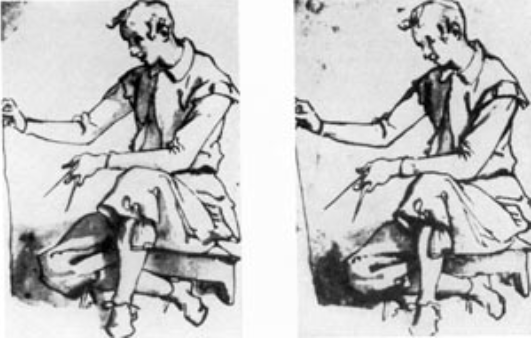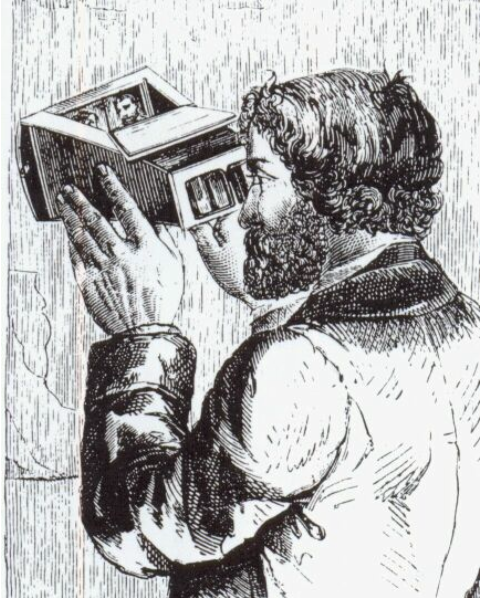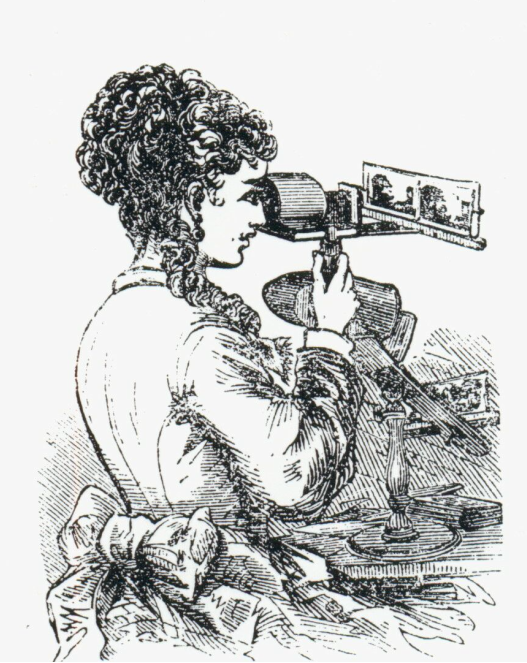An Introduction to the Stereo Image
Stereoscopy (greek stereos = space/spatial, solid – skopeo = view) is the reproduction of pictures with a stereoscopical impression of depth, what is physically non existent.
The principal is based on the fact that humans, like all primates and also like most predators, view their surrounding through both their eyes at the same time from two perspectives. It is due to this that their brain can efficiently allocate a distance and a stereoscopic picture of its surroundings for all viewed objects. Hence stereoscopy is only concerned with bringing two different two-dimensional pictures from two slightly deviating viewing angles into the left and right eye.
A stereophoto only offers information to the eyes that is received from the different viewing angles. Due to the fact that the eye usually aims to adapt the lens power to the supposed distance, a defined image on the retina is formed with a certain time deferment (within milliseconds). The discrepancy between the supposed distance of the seen object and the actual bending of the lenses causes dizziness or indisposition for some people.
With a stereo camera, that shows two objectives with an eye distance of approximately 68 to 72 mm, both required half pictures are recorded at the same time (synchronic). Every individual picture is described as a stereoscopical half picture and the picture pair is described as a stereoscopical picture.
Already during the 4th century BC the Greek mathematician Euklid addressed stereometry in his 11 – 13 volumes of his mathematical textbooks. He just did not know then that two eyes are necessary for the physiological stereoscopic viewing impression. Leonardo da Vinci was also involved in this matter.
A double ink drawing from Jacopo Chimenti da Empoli exists that was drawn around 1600. If the drawing is viewed through a device which results in each eye viewing only the relevant picture then a bodily dimension of the person can be seen. This drawing is believed to have been drawn for Johann Baptista Porta, a scientist from Neapel, who tried to prove the three-dimensional effect visually in his book that was published 1593.
Similar attempts were made in 1817 in Italy with two complete drawings of both pictures that were separated for each eye and the assembly of these to a unified picture, within which one could not only recognise the principal of stereoscopy but also the basics of its construction. Two stereoscopic drawings that still exist today are called “Aufstieg zum Vesuv” and “Abstieg vom Vesuv”.
During the year 1834 James Elliot, a Scottish man, had the idea of constructing an apparatus that was to allow the viewing of two dissimilar pictures “simultaneously” that were to create the impression of an elevated object. Although he did not implement this construction until three years after the publication and production of the first stereoscope by Wheatstone in the year 1838.


Sir Charles Wheatstone (1802–1875) published his first research results about stereoscopic vision in the year 1838. He calculated and drew stereo picture pairs and he constructed an apparatus for their viewing that deflects the view of the observer through mirrors onto the half pictures. He called this apparatus a stereoscope. Wheatstone achieved the merging of the two part pictures through his mirror-stereoscope consisting of two mirrors that are inclined against one another at a right-angle and whose planes are vertical. The observer used his left eye to look into the left mirror and the right eye to look into the right mirror. At the side of the mirrors there were two moveable slats that incorporated the reversed perspective drawings of an object. The mirrors reflected the rays that resulted from the relevant points of both drawings in such a way that they seemed to come from a single point that was positioned behind the mirrors. Each eye therefore saw its respective picture and the observer received the stereoscopic impression. This is the beginning of stereoscopy.
Following the publication of the process of the creation for the fabrication of photographic images on silver plates by Louis Daguerre in the Science Academy in Paris in 1839, it suggested itself to also fabricate stereoscopic double images that up until then only existed in the form of drawings.
Sir David Brewster (1781 – 1868), who was actually a pharmacist, a lawyer and also a professor of physics in Edinburgh followed up Wheatstones concept. As he was the inventor of the kaleidoscope he was aware of light refraction of crystals and he introduced the first stereoscope but he did not earn any recognition. In the spring of 1850 Dundee manufactured the first stereoscope in London. Brewster took this to Paris to Abbe Francois Moigno (1804 – 1884), whose publications contributed greatly to the promotion.
In the year 1854 the first multi-band camera was introduced by Sir David Brewster, which for the first time made it possible to take stereoscopic snapshots. Up until then the stereo half images had to be exposed one after the other and the camera had to be moved in-between the two shots within eye distance, which could lead to different image contents for moving motives that did not allow a stereoscopic impression. The standard stereo format at the time was 9 x 18 cm, these cards contained two images of the format 8 x 8 cm; nevertheless the resulting stereoscopic image seemed very big. Due to the fact that at the time it was nearly impossible to bevel two identical lenses monocular cameras remained in use for a long time even though moving objects could not be photographed. It was not until the end of the 50ies that it became possible to produce identical lenses and with this binocular stereo-cameras became fashionable. The London based company Brand and Long announced as early as 1857 a stereo-camera with two lenses, never the less the monocular camera is still recommended 1864 in the contemporary specialist literature. In France Mr Quinet invented a binocular camera that he called quinetoscope in the year 1854. A similar development was introduced 1856 in Germany by the company Emil Busch. Already in 1857 they advertise four different binocular stereo-cameras.
In the same year Brewster simplified the stereoscope by replacing the mirrors with lens-like bent prism. For these instruments a collective lens of approximately 18 cm focal length was cut into two semi-circular parts; both halves were fixed in a frame with their circular edges positioned against each other. A sheet was inserted behind the lenses in viewing direction, which contained both drawings (or photographic images). Through the lens parts on the one hand the images were brought closer similar to a magnifying glass; but then on the other hand they also functioned as prism, because the lens half in front of the right eye seemingly moves the image slightly to the left, whereas the image of the drawing that is seen with the left eye seems to be slightly moved to the right. In this way both images were completely integrated if their optical angle was further apart than the distance between the eyes (approx. 68 mm), through which the images could be wider and could cover a wider angle of vision. Stereoscopes of this kind with paper image series were generally in use in the 19th Century. However mostly two small lenses were used, whose optical angles coincided with the eye angles (so without-prism-wedge effect) and the pairs of 6 x 6 cm small images that were adapted to the eye distance.
Brewster Stereoscope

The optician Jules Dobascq (1817 – 1886) from Paris recognised the importance of three-dimensional photography during a meeting with Brewster and he began to develop stereo cameras with two lenses immediately. In 1851 Dobascq assigned the daguerreotypist Claude Ferrier to manufacture a series of daguerreotypes for his apparatuses and he introduced these to the public at the world exhibition in London. These were stereoscopes designed according to Brewsters constructions with which he showed stereo daguerreotypes. The publics’ response was overwhelming and Queen Victoria was enthused by the presentation. It was for this reason that the triumphal procession of stereo images could no longer be detained. Following this exhibition Dubosq was overwhelmed with orders; within three months approximately 250.000 apparatuses were sold in Paris and London. From then on flocks of photographers took stereoscopic photos during their excursions throughout the world. Already in the year 1853 Claudet produced his first pocket- or travel case with a daguerreotype contained within. A similar album had already been patented by John F. Mascher in Philadelphia (USA).
1850 Blanquart-Evrard, the owner of the Calotype Copy Institute in Lille, invented albumin paper. The photo paper was covered with a mixture of albumen, potassium bromide and acetic acid. After drying a silver nitrate solution was applied. Now finally a cheap copying procedure was available. There were pictures of far away countries and their inhabitants and the popular series with humorous illustrations for the adults. Fairytale images were produced for the children. Hundreds of erotic series from France were released on the market.
The „London Stereoscopic Company“ could declare itself as the largest manufacturer of stereoscopes with the associated viewers already around 1856. But alone in England nearly a dozen other producers as for example Meagher in London existed. A similarly excellent development was apparent in France, especially in Paris. Photographers often signed their images only with their abbreviated initials due to the fact that erotic pictures or nudist shots sold well, but were actually prohibited. The photographers were even threatened with prison sentences.
Around 1880 in Berlin the German physicist August Fuhrmann developed a large concentric run-out stereoscopic viewer, the Kaiser-Panorama; it’s advantage was the manual colouring of every individual glass picture. In central Europe the so-called Kaiserpanorama became a popular mass medium around 1900. Within Europe 250 branches were established and approximately 150.000 coloured glass picture stereoscopes were produced. Herewith the population achieved virtually the first world-wide newsreel. It was not until 1939 that the company collapsed.

The largest producer of stereo photo cards and stereo viewers in Europe has more or less been forgotten. From around 1894 until 1921 the “Neue Photographische Gesellschaft Berlin-Steglitz“ produced and sold more than 7.000 motives from all over Europe and some from Asia and America. The company also offered some viewers that were sold as hand- and travel-viewers.
The stereoscope design that was developed by Oliver Wendell Holmes in 1861, a stereoscope with focus, became the De-facto-Standard which was the most popular. The photographer Joseph Bates took over the production in Boston. From the end of the 19th Century onwards it also won recognition in Europe where it was known as the American stereoscope.
The adjacent picture shows a table version with a pedestal as well as a hand held stereoscope.
Here in Europe many hand viewers, some also with pedestals, were produced. Besides the Holmes handheld viewers especially table viewing automatons were developed in the USA. A US patent was registered on the 7.04.1857 by Alexander Becker in New York, which protected his table viewer with 50 images that were fixed on a transport belt. These were described as “Stereoscop americain” and they could partly be used by two viewers simultaneously. They were quickly copied in Europe.
Due to the war 1870/71 the stereo-enthusiasm suffered a major set back because the stereo images, especially the hand coloured ones, cost nearly a workers weeks wage each. It was not until automatic photocopy methods were introduced commencing 1890 that a new revival occurred. In addition new cheaper picture formats were developed with the sizes 45 x 107 mm and 60 x 130 mm. The driving force behind this was the company Jules Richard Paris, who enabled layman and amateur photographers to produce stereoscopic images. During the following 70 years this company not only produced cheap stereoscopic cameras and countless viewers under the name “Verascope” but they also produced a large sequence of stereo-series on glass plates. Jules Richard himself produced many aesthetic and compositionally valid nudist images of individual women and groups in his studio, an atrium with a water basin and in the garden of his dwelling. He also developed a glass plate positive photocopier from within which from the negative plates of the cameras, transparent glass plates for viewing in his handheld apparatus but also for his table automatons or those of Mr E. Ziegler, could be withdrawn.
During these times stereoscopy considerably influenced social life in Europe and America, including Japan after the opening. Various picture materials were distributed throughout broad levels of the population in a time without radio and television. Whilst in Germany, due to the disruptions of World War I, only rather simple apparatuses were being produced by Bing, Ernemann, Franke & Heidecke, von Liesegang and Plaubel and others, stereoscopy continuously proved to be very popular with the French. Companies like Brugiere, Educa, Gaumont, Mackenstein, Mattey (Unis), Jules Richard and others produced different types of viewers and viewing automatons that also covered the new sizes 70 x 130 mm. Later the stereo picture cards were added which brought about new companies such as Lestrade and RoMo.
In 1939 the Nazis discovered the propaganda potential of stereoscopic images and they used these for their purposes. This increased the publishers Schönsteins’ importance and they produced picture series and books up until the beginning of the 50ies.
In the USA especially Keystone and Underwood & Underwood sold their products up until the 50ies. There were always new picture series assorted such as “Primary” or diverse “Tour of the World”, or stereo cards of individual countries and these were complemented informatively by book manuscripts. All models of the telebinocular viewer by Keystone convince right up until today through an impressive stereoscopic effect when viewing the images. This applies to the art deco models through to the electrified edition that was delivered in a book box. Keystone produced approximately 20.000 different stereoscopic cards and was not liquidated until 1978. Underwood & Underwood already closed their business in 1940, but up until then they produced between 30 to 40 thousand titles. At their best they produced and sold ten million cards yearly.
The organ builder Wilhelm Gruber invented the view-master 1938, a stereoscopic viewer with exchangeable picture discs, that remains a bestseller up until today. It was originally developed for educational purposes for schools, like the EDUCA in France, but it then became one of the most popular toys. These apparatuses were first produced by Sawyers in the USA, later they were also produced by GAF in Belgium and nowadays they are owned by the company Fisher Price Mattel Inc. Mexico. These viewing apparatuses were also reproduced or rather copied better in the DDR, in Czechoslovakia, in Japan, Italy, Russia and in China.
A further new development regarding candid cameras occurred in the 50ies. Candid stereoscopic cameras with two lenses were manufactured. Especially German producers, such as Iloca (Witt), Ediax (Wirgin) and the company Leitz found a huge retail market in the USA. But a further innovation, the development of a stereoscopic beam splitter, also achieved a record turnover. Nearly all the large camera factories released these attachments for their candid cameras and the associated viewers. On the small image film of 24 x 36 mm two half images of 24 x 18 mm were created, that also conveyed a good stereoscopic impression and they could easily be projected. In order to view these simply specialist glasses were required. Stereoscopes for at home become fashionable once again. Publishers were offering stereoscopic cards from all over the world.
Due to the high technical complexity stereoscopic photography could not permanently establish itself so far. Nowadays thanks to the introduction of the digital camera it is experiencing a slight renaissance because the expensive photo paper is not required, because slides do not have to be framed laboriously and because experiments are less costly. Digital picture processing brings with it new possibilities for stereoscopy. The fascination for the three-dimensional picture has remained. The new 3D-films of the entertainment industry have increasingly renewed the interest for stereoscopy in the last few years.
Peter M. Stajkoski 2023
